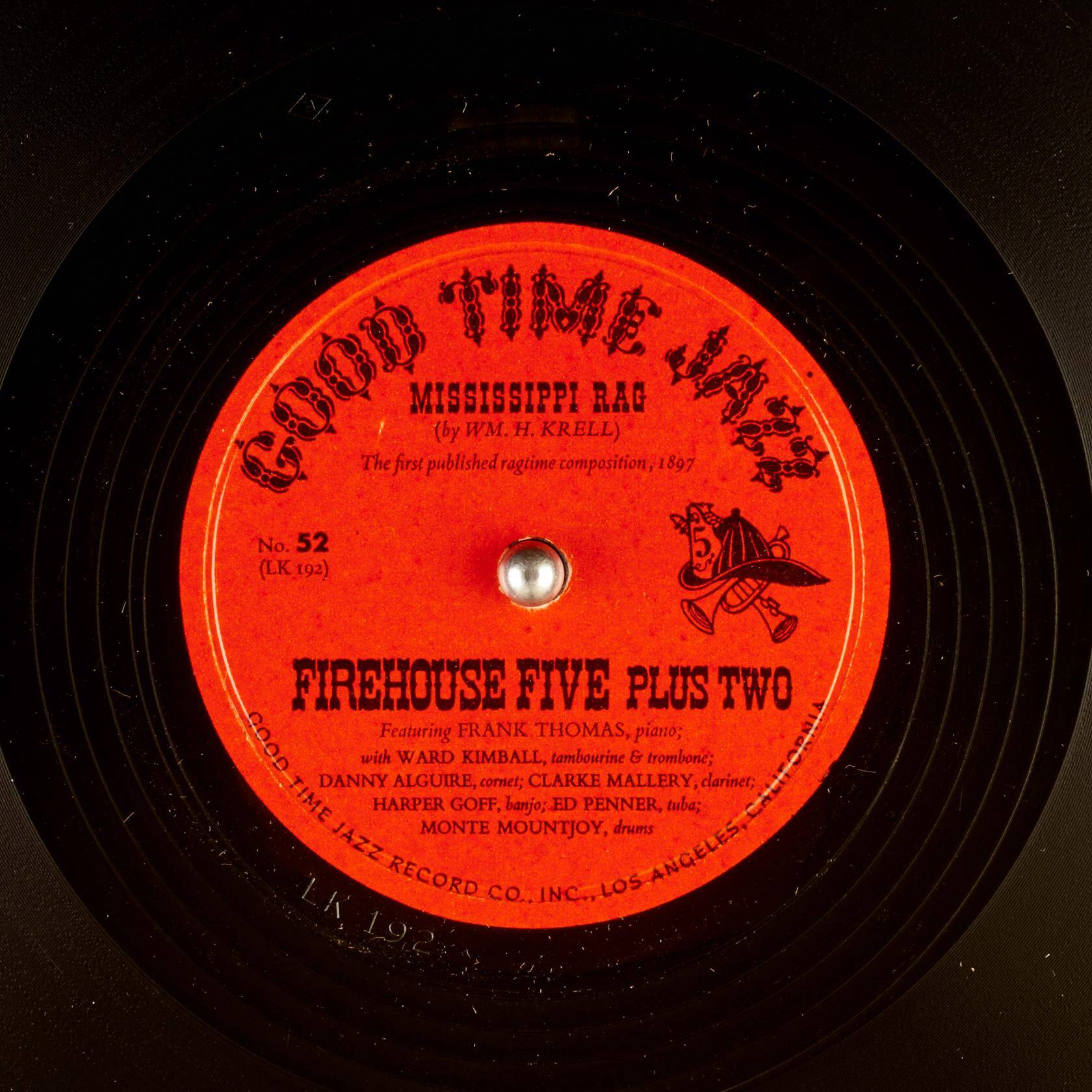
Jeff Barnhart: This month, we conclude our exploration of the Firehouse Five Story, with plans to revisit the band and examine their many themed albums in future columns. In last month’s entry, we covered 1949-1950, the formative years of the band. Things really started to gel in 1951 and, Hal, you mentioned you had a good amount of insight and comments to share about the band’s recorded output in 1951 so could you start us off?
Hal Smith: Yes, but you may have to call a time-out on me if I get too carried away! The first session of 1951—March 9—produced “Sobbin’ Blues,” “Sweet Georgia Brown,” “Lonesome Mama Blues,” and “Mississippi Rag.”
“Sobbin’ Blues” was in the repertoire of other West Coast Revival bands, including Lu Watters’ and Bob Scobey’s, so it isn’t surprising that the Firehouse Five played it. They take it at a pretty good clip, with lots of wa-wa muted cornet by Danny and piano fills by Frank Thomas over the first ensemble. Clarke Mallery’s clarinet has a real old-time sound and I like the tuba playing straight melody with cornet obbligato (a feature that the band would use for many years). I’m surprised that Ward Kimball didn’t keep this one in the repertoire.
I’m sure that “Sweet Georgia Brown” was one of the numbers the band played for the “Charleston contests” at the Mocambo nightclub in Hollywood. Harper Goff’s vo-do-do-de-o scatting almost overwhelms the vocal by Danny and Ward. When the band played this song in later years, it included a duet between George Probert on soprano sax and Ward throwing a cymbal up in the air, catching it and playing hot choke rhythms! Note the unusual key of Eb. (Most bands play “Sweet Georgia Brown” in Ab or F.)
“Lonesome Mama Blues” is another good vintage pop song which disappeared from the band’s repertoire after this recording. There were quite a few records of it in 1922-1923, including performances by Mamie Smith, The Virginians, Ladd’s Black Aces, Edith Wilson, the California Ramblers, and others.
Before I go into detail on the final title from the March 9 session, what are your thoughts on the first three songs, Jeff?
JB: The “wa wa” intro to “Sobbin’ Blues” by Ward and Danny is perfect: unique and humorous without parodying. Frank’s piano fill-ins are hot and I’ve ALWAYS loved tuba playing melody while cornet plays hot obbligato. The repeat of the verse features terrific breaks for Clarke’s florid clarinet into a final chorus that builds beautifully! I marvel at the heat Danny Alguire produces while never leaving the mid-range of the cornet; no blistering pyrotechnics here: just solid, shirt-sleeve, and insouciant playing that molds the rest of the ensemble around him. Lead horn players today purporting to play traditional jazz can take some notes.
The unusual key of “Sweet Georgia” allows for some hot playing!! Frank Thomas barrelhouses his way through a chorus with abandon and the vocal chorus still makes me grin ear-to-ear. Danny plays a muscular half-chorus followed by Clarke’s pungent clarinet and a hot ensemble chorus to conclude. Abundant surprises in three minutes!
When I first heard “Lonesome Mama” in my early teens I mistook it for “I Ain’t Gonna Give Nobody None of My Jelly Roll” and thought “These guys are playing it wrong…” LOL! I love Ed Penner playing four-to-the-bar tuba during the bridges of the tune. The recording exemplifies the variety this band could create from chorus to chorus. Danny’s half chorus is torrid!! The offbeat fire bell during the final bridge reminds us we are in FH5+2 territory, and the cowbell (this time Tom-tom) ending is followed by a surprise rallentando. This band was at its prime here.
I’m going to preempt your comments on “Mississippi Rag,” Hal, with a quick story. I’d never heard this rag from 1897 by William H. Krell until this recording, and so I learned it by ear from this version—everything from the VERY quick tempo to Frank’s wonderful rewrite of section B; when I played it like that at ragtime festivals I was deemed a heretic!! This rendition is reminiscent of the great Wally Rose recordings with rhythm until the final “hit-you-between-the-eyes” ensemble chorus: that is PURE Firehouse Five! Hal, before you lead us into the next 1951 recording date, tell us what you hear on this tune…
HS: You stole my thunder! But I am glad that you mentioned the similarity to Wally Rose’s recordings with rhythm. Unfortunately, “Mississippi Rag” is the only side by the Firehouse Five which features Frank Thomas throughout. He was an excellent band pianist who played at both ends of the keyboard—as did Wally. I wish that Frank had recorded more solos (or solos with rhythm), but at least he was given solo choruses on the majority of the band’s recordings well into the 1960s. Frank had a wonderful beat and a lilting style which really gave a lift to the Firehouse Five rhythm section. His playing also reminds me of another under-rated pianist: Hank Ross, who worked with the Red Onion Jazz Band. I think Wally Rose, Frank Thomas, Hank Ross, and Paul Lingle were the best band ragtime pianists of the Revival.
You mentioned being influenced by Frank Thomas’ interpretation of the second strain of “Mississippi Rag.” Have you heard Claude Bolling’s 1967 recording of the song? It was definitely based on Frank’s recording from 1951!
JB: Bolling’s rendition (and his entire 1967 ragtime recording—his “Robert E. Lee” leaves me breathless) is an incredible amalgamation of ragtime, hot jazz breaks—both Mortonesque and modern—and precision pianistics, with YES, not only Frank Thomas’ solo recreated note-for-note in two different keys but the spirit of the FH5+2 version gleefully cakewalking above it throughout! Thanks for reminding me of Bolling’s iconoclastic and exciting ragtime playing, Hal! What’s next?
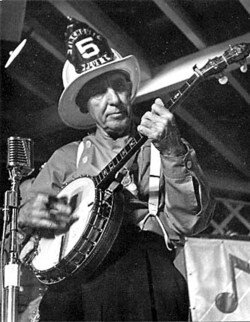 HS: The next session, from June 12, 1951, introduces a musician who would become a regular with the band in just a few more years: banjoist Dick Roberts. His background included a stint with Spade Cooley’s Western Swing Orchestra (playing steel guitar!) and a long association with banjoist Red Roundtree in the popular “Banjo Kings.” Dick Roberts was a professional musician and did not work for Disney Studios.
HS: The next session, from June 12, 1951, introduces a musician who would become a regular with the band in just a few more years: banjoist Dick Roberts. His background included a stint with Spade Cooley’s Western Swing Orchestra (playing steel guitar!) and a long association with banjoist Red Roundtree in the popular “Banjo Kings.” Dick Roberts was a professional musician and did not work for Disney Studios.
“Just A Stomp At Twilight” has a little bit of hokum with Frank Thomas playing organ. It really takes off immediately following Clarke Mallery’s clarinet solo. I keep expecting it to turn into “Oriental Man” before the coda on the organ!
“Show Me The Way To The Fire” (a/k/a “Show Me The Way To Go Home”) is pretty thin material. The band did their best to jazz it up, including another hot muted cornet obbligato to the lower brass, quoting “How Dry I Am.” Dick Roberts plays an excellent half-chorus before Frank quotes “How Dry I Am” once again. The out chorus is about as hot as you could play on this song, complete with a coda by the firebell and banjo (in case anyone had forgotten which band was playing the song)!
As before, I want to go into detail on the two remaining titles from this session after your comments on the above, Jeff.
JB: “Just a Stomp” was a reimagining of the Victorian ballad from 1884 called “Love’s Old Sweet Song,” with the first line of the lyric—“Just a song at twilight”—taking on greater recognition as the title. I love the melody and the sweet harmonic structure of this tune; rather than hokey, I find the camp meeting organ intro and coda to be poignant—a nod to simpler times gone by. I love the build of this rendition: camp organ statement of the melody with banjo strumming behind, Danny’s cup-muted cornet, then clarinet and trombone duetting and two STOMPING choruses getting hotter and hotter with each bar! Throughout the entire version, the melody is always heard. Simply beautiful.
I agree with your summation of the “Show Me” song although I am always juiced by Clarke Mallery’s red hot clarinet on this out chorus, as well as all the others he recorded with this band. Lead on, Mr. Smith; what’s next?
HS: “Who Walks In When I Walk Out” is red-hot! I like everything about this side—Frank Thomas’ fills over the vocal duet, the chase chorus between the horns, more fine banjo playing, a rare tuba solo by Ed Penner, Clarke Mallery’s bridge, the clarinet wailing over the last ensemble and of course…the “marching men” sound effect! This is a song that I heard the band play live—many times! Interestingly, it worked at a variety of tempos. I can recall hearing it at a similar tempo to the original recording and also at a medium tempo, when Don Kinch was added to the front line on trumpet. That gave the song a real Lu Watters-style feel.
“Who Walks In” was in the repertoire of Bob Wills’ Texas Playboys. In fact, you and I discussed their recording of it in our column from May, 2021 (“Bob Wills Stomps and Swings Western Style,” TST, Vol. 6, No. 5). I always wondered whether Danny Alguire was responsible for bringing this song to the Firehouse Five.
However, I know the next song came from the Texas Playboys. “Fire Chief Rag” is Danny’s hot jazz interpretation of the old Texas fiddle tune “Beaumont Rag.” Danny must have heard it numerous times when he was with Bob Wills, as a lot of the older Wills fans objected to the swing and jazz sounds and requested fiddle tunes for dancing!
As far as I am concerned, “Fire Chief Rag” is one of the TOP records by the Firehouse Five Plus Two. There is absolutely no gimmickry; just straight-ahead, stomping traditional jazz. Frank Thomas plays two great solo choruses (almost going into the Jelly Roll Morton style in the 7th and 8th bars of the first chorus) and Dick Roberts once again comes through with a beautiful strummed solo. And of course, the composer played just the right amount of notes, in that wonderful, relaxed cornet style that is so reminiscent of Benny Strickler. I rank this one with the best Revival recordings by Watters, Murphy, Scobey, Bay City, Castle, et. al. As you can tell, this is one record I would grab in a fire (pun not intended)! I hope you like this one half as much as I do, Jeff. (N.B. In 1990, my Frisco Syncopators recorded “Fire Chief.” Chris Tyle was on cornet and really channeled Danny Alguire. When the recording was released, I sent a copy to Danny and he sent back a beautiful note thanking me for recording it and complimenting Chris on his outstanding cornet playing).
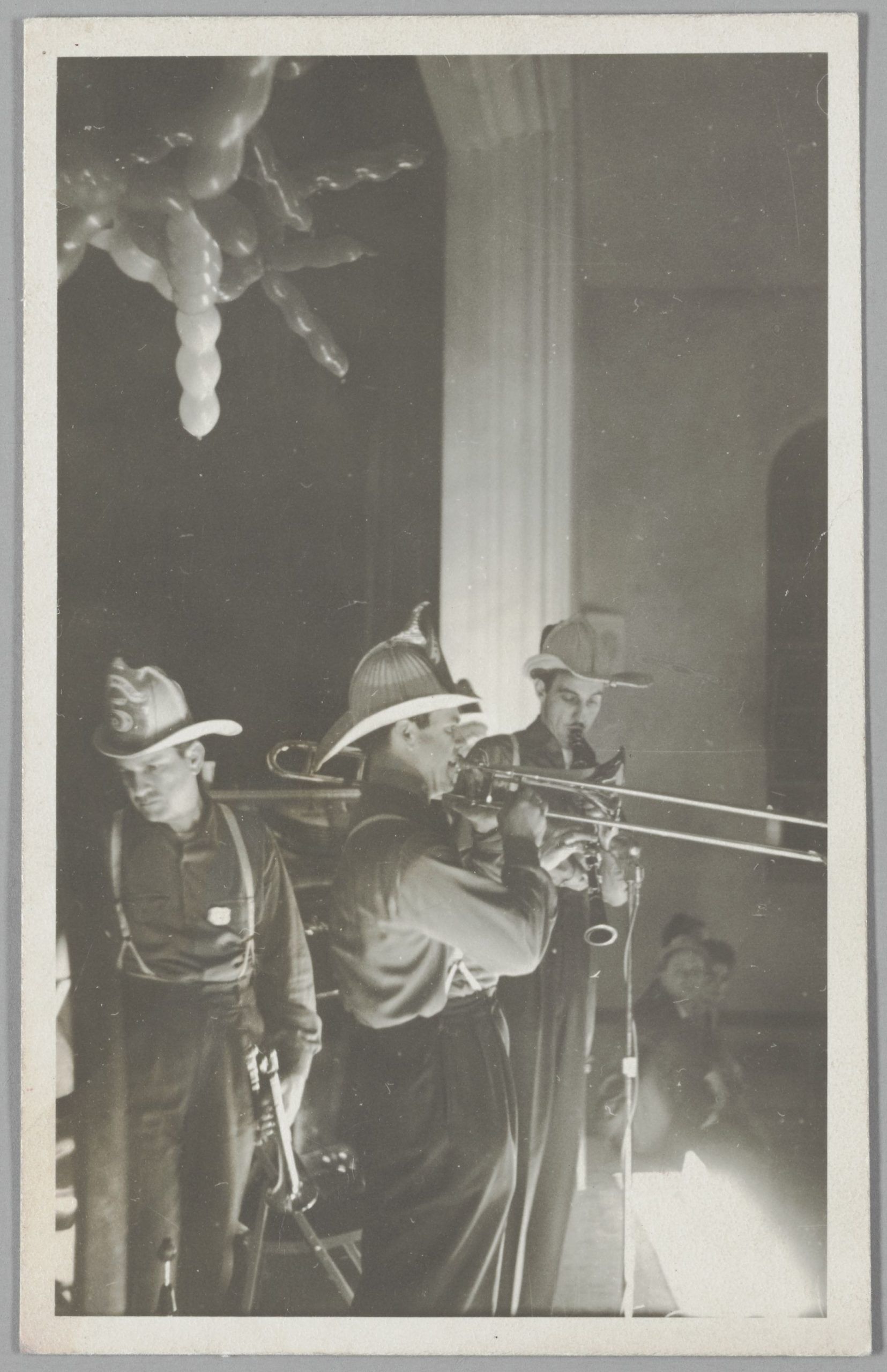 JB: When I first encountered the band, part of the allure was their connection with Disney animation; I was a fan of all the classic animated features of the 1930s-’40s. So when I heard the “marching men” break and outro on “Who Walks In” I started laughing out loud (“Hi-Ho, Hi-Ho, it’s off to work we go!”). That chase chorus still gets me, with Danny bending notes until they seem about to break! If one listens to this original version and then the one they assayed during their appearance at Earthquake McGoon’s (GHB BCD-450) that’s a REAL study in contrasts within a band; 19 years apart with some personnel changes and the opportunity to stretch out for almost six minutes creates a totally different experience!
JB: When I first encountered the band, part of the allure was their connection with Disney animation; I was a fan of all the classic animated features of the 1930s-’40s. So when I heard the “marching men” break and outro on “Who Walks In” I started laughing out loud (“Hi-Ho, Hi-Ho, it’s off to work we go!”). That chase chorus still gets me, with Danny bending notes until they seem about to break! If one listens to this original version and then the one they assayed during their appearance at Earthquake McGoon’s (GHB BCD-450) that’s a REAL study in contrasts within a band; 19 years apart with some personnel changes and the opportunity to stretch out for almost six minutes creates a totally different experience!
THAT’S why “Fire Chief Rag” sounded familiar! My parents had a few old-time fiddle albums and “Beaumont Rag” was on nearly every one of them, but I NEVER connected the two. The FH5+2 rendition is the perfect tempo for listening and dancing and remains one of my favorites as well. Happy jazz with a ballsy attitude! What more can one desire? And really nice story about your Alguire-Tyle connection, Hal. Chris remains one of the best disciples of the Strickler-Alguire style and it’s too bad he’s no longer widely playing.
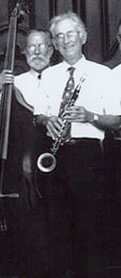
We’re moving to the final session of 1951, recorded on Nov. 3, with Harper Goff returning to the banjo chair and Monte Mountjoy being replaced by Jerry Hamm. Besides the wide variety of styles and tune selections for that day, what stands out for you on this date, Hal?
HS: I wish I knew more about Jerry Hamm! He played nice drums. He recorded with the Banjo Kings and though he was never a regular member of the FH5+2, he continued substituting as late as 1955 (the Los Angeles “Dixieland Jubilee” program for that year lists him as the drummer). Otherwise, “Five Foot Two” is taken at a pretty good clip, which must have resulted in some spectacular Charleston dancing at the Mocambo! Harper Goff’s falsetto comments distract from the vocal duet, but I like the spirit of the band on this one. (Years later, I remember hearing them play it at a considerably slower, foxtrot-like tempo at Disneyland. That was effective too)!
“South” was popular with jazz bands beginning with Bennie Moten’s first recording of it in 1924. Lu Watters, Bob Scobey, and Turk Murphy recorded it and I understand it was also one of Bob Wills’ favorite numbers. Actually, I am surprised that the Firehouse Five played it at such a bright tempo. Check out the version from the same year, recorded for Snader Telescriptions. The difference in feel is astonishing! Maybe the tempo used for the Good Time Jazz record was chosen because of the 78rpm time limit(?)
I never cared for “Chinatown, My Chinatown” and can’t think of any instrumental combination that would make me like the song—especially the Firehouse Five’s politically incorrect version! (Though I will say that Harper Goff sounds terrific on his solo).
“San Antonio Rose” is another of my all-time favorite recordings by the FH5+2. No doubt Danny Alguire played this one with Bob Wills (and probably with T. Texas Tyler as well). On this number—especially on his solo bridge—Danny clearly demonstrates that he was playing close attention to his friend from Fayetteville, Arkansas, Benny Strickler, when they played together in the Texas Playboys brass section! This is a real, honest traditional jazz, without the gimmicks that were used on the song in later years. I think the out chorus, particularly the trumpet lead, is one of the highlights of San Francisco Style jazz on record. The only way I can think to improve this side would have been to include a vocal by Danny! What are the highlights of the November 3 session for you, Jeff?
JB: Hearing the “Five Foot Two” vocal, I wonder how much they’d been listening to Spike Jones? The Charleston chorus is hot, with Danny bending those notes again and Ward’s filthy trombone. It leads into a stomping final chorus with the ubiquitous double ending. Jerry Hamm belies his surname, letting the other firemen do the hokum. A nice track, but “South” stands out for me. While it is a bit brisk it’s solid, and the repeat of the verse before the solos is simmering, with smeary blue notes from Mallery. Frank plays a rollicking piano solo into a chalumeau clarinet ride, giving way to a blistering cornet solo; Danny uses space to emphasize his hot rhythmic phrasing and I can see the dancers stepping a little higher! After Ward’s tailgate solo it’s one final time through the verse and a killer out chorus with Mallery briefly channeling Pee Wee Russell. This band knew how to liven up a party!
It had been decades since I listened to “Chinatown”; all I can say is they provide a spirited out chorus and, yes, Goff really could play.
“San Antonio Rose” was one of my favorites when I first heard it; I LOVED Frank’s barrelhouse piano, the ensemble that follows it and that lovely tuba melody with clarinet obbligato. Danny blares in with a heated solo and Ward takes no prisoners. The final chorus has everyone playing hot. As a note, the version on the Earthquake McGoon’s recording, while filled with some spurious novelty effects, is a slower tempo and DOES feature Danny’s vocal.
In 1952, the band only recorded four tunes on one session but they were all great numbers, prompted by the knowledge that this was their planned swan song. Take us through these, Hal.
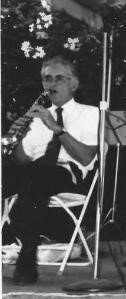
HS: At this point, the Firehouse Five Plus Two was probably the most popular jazz band in existence. And also the most worn-out! Except for Danny Alguire, everyone else had to report bright and early to their day jobs at Disney Studios after all the late night gigs in Southern California and traveling to out-of-town engagements. When you add in the time away from family obligations, it was clear that the situation could not continue. So—the band decided to disband after the recording session of May 20, 1952. On this date, we hear the great Tom Sharpsteen, a disciple of George Lewis and Alphonse Picou, on clarinet. His father Ben was a famous Disney animator and Tom originally drove the fire engine for FH5+2 gigs where the machine made an appearance! Later, Tom received worldwide acclaim as one of the best clarinetists of the Revival and carried on playing righteous New Orleans jazz until his death in 2007.
However, to my ears the band sounds unsettled and nervous on all four sides from this session and the recording quality is unusually shrill. Maybe it was time to take a long intermission!
JB: My friend, I must (in a RARE instance) disagree with you. 1952 produced at least three classics! “Old Green River” rocks along with brilliant ragtime piano backing the first ensemble, an admittedly goofy, drunken vocal (with AWESOME piano backing AGAIN) and a terrific trombone/clarinet duet followed by another red hot cornet solo, then piano (interestingly by now, with thumbs tacks for that “authentic” ragtime sound) and a KILLER out chorus!! Same with “When You Wore a Tulip.” Sharpsteen’s facile phrases during the solid opening chorus lead us into tuba melody with chalumeau clarinet obbligato, then a burst of cornet heat, followed by 1/2 chorus banjo, piano and trombone solos assayed with complete abandon! One-and-a-half choruses of ensemble culminate in a hell-raising double ending accented by splash cymbal and everyone needs to take a nap!!
“Lonesome Railroad Blues” starts with a “train effect” intro to a bluesesque verse in minor, then into a hot 18-bar chorus (16 bars with two-bar tag), a group vocal, a muted trombone chorus into a reprise of the bluesy verse and a molten cornet break into the final freight-train ensemble with surprise firebell/train whistle ending.
Finally, there is the coup de grace: “Runnin’ Wild.” The band’s swan song enlists ALL that had come before: special effects (Ward’s 1914 American LeFrance fire truck starting up and the CRASH ending); the firebell, a full chorus by galvanizing banjo, breaks for walking tuba line, smoldering ensemble, MORE banjo, TWO full ensembles out with fire sirens, whistles, and primal screams AND the final sound effect—a fatal crash that no doubt killed everyone! They knew (at least thought) that this was their final hurrah and threw in everything but the kitchen sink—maybe even THAT!
Okay, maybe it’s because I was about 14 when I first heard “Runnin’ Wild,” but this recording remains for me an apex of polyphonic anarchic id! The band did break up, but would reform and continue to even greater heights from 1954 to the early 1970’s, and we’ll explore this stage in future columns.
Next month, let’s tackle the Mt. Everest of early jazz tunes: “Copenhagen!” There’ll be sections and notes flying every which way with that one!
Bonus TV Appearance Videos:
BING CROSBY RADIO PROGRAM Jan. 31, 1951
Jeff Barnhart is an internationally renowned pianist, vocalist, arranger, bandleader, recording artist, ASCAP composer, educator and entertainer. Visit him online atwww.jeffbarnhart.com. Email: Mysticrag@aol.com
Hal Smith is an Arkansas-based drummer and writer. He leads the El Dorado Jazz Band and the
Mortonia Seven and works with a variety of jazz and swing bands. Visit him online at
halsmithmusic.com
























